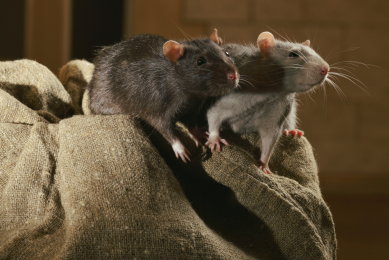Tips on rodent control for broiler farmers

Controlling vermin populations on broiler units is an integral facet of farm management, but the efforts applied by producers are often found to be ineffective.
Rat populations can escalate quickly if left unchecked and a unit can become over-run in 3 months.
Poor vermin control inevitably results in re-infestation and prolongs on-going health risks such as salmonella, which can be transferred from vermin to poultry.
Poulty World spoke to rodenticide expert Sharon Hughes, BASF’s global technical marketing manager and Paul Saven, director of Merseyside-based Instant Pest Solutions to find out why rat control programmes often fail and how to apply a successful strategy.
Reasons for poor control
Paul Saven of Instant Pest Solutions says poor control is often the result of not carrying out an initial site survey to assess the infestation.
No survey or a poor survey will cause issues with baiting effectively. A common problem is under-baiting, which can result in rats and mice becoming ‘bait aware’ or ‘bait shy’ and control starts to fail.
The main baiting issues are:
- Bait placed incorrectly – as rats are climbers so baiting needs to be in high and low locations
- Too few bait points for the level of infestation
- Too little bait at each bait point
- Bait not replenished as per label
- History of the site not taken into account (resistance, bait preference)
- Bait chosen not the most appropriate
- Bait boxes inappropriate
- Bait and/or bait boxes moved or removed completely
- Re-invasion from neighbouring areas
- Anticoagulant resistance
Professional services
To ensure baiting is carried out effectively, the experts recommend employing the services of a professional vermin control operator, preferably with a formal qualification under the British Pest Control Association.
A professional will ensure infestation problems are tackled correctly in the all-important initial stages, as well as creating effective long-term plan for control.
Paul Saven says the process will begin with a thorough survey of the site and should include a detailed assessment of proofing issues of all the buildings.
The aim of an effective programme should be to significantly reduce a vermin population within the first 3 months, and then to move to a sustained monthly baiting programme to maintain control.
Elements of a control programme will include vermin proofing buildings, reducing feed and muck spillage and applying strict hygiene measures.
Poultry producers should also expect pest operators to provide them with a ‘trend analysis’ as a means of showing how effective the baiting has been.
Baiting programme
Because 80% of the rat population resides in burrows outside the structure, intensive baiting operations will and can have a significant impact on control.
Recommended baiting technique:

Steps to prevent reinvasion
Rodenticide expert Sharon Hughes underlines that the control strategy should be actively maintained. Before bait boxes are removed or moved, steps should be taken to prevent reinvasion from neighbouring areas.
Key to this is finding out how rats are entering the building and addressing any necessary repairs.
A heavily trafficked runway of rats is often evident from the “smear” marks left where they enter a building.
Signs of rodent activity that should be noted include urinary pillars where rodents are urinating repeatedly in the same place.
These are used primarily as communication pillars and need to be included in the site plan at the outset.
 Beheer
Beheer











 WP Admin
WP Admin  Bewerk bericht
Bewerk bericht